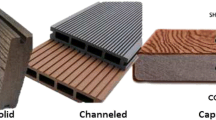Abstract
Using a newly developed binding system, a new generation of periclase-carbon refractories bonded with a carbonaceous binder with a low emission of hazardous volatiles is proposed. The new binding system gives a high coking yield in carbon, which provides favorable conditions for very strong carbon-based cross-linking. Another advantage of the new system is high resistance to oxidation and thermal stress. The newly developed products have been successfully marketed under a trade mark ANKERSYN. ANKERSYN components were tested, with good results, on a 270-ton oxygen converter (BOF) at the Sollac Atlantique Co. (France). ANKERSYN makes it possible to manufacture products with superior performance characteristics, in conformance with the ever-demanding requirements placed on the production technology and environmental protection.
Similar content being viewed by others
References
G. Buchebner and S. Pirker, “New high-performance refractories for BOF use.” In: XXXIX International Colloquium on Refractories, Aachen, Germany, Sept. 1996. Stahl und Eisen, Special Okt., 40–45 (1996).
W. Boenigk, D. Schnitzler, J. Stiegert et al, “A carbon speciality to improve the performance of refractories bound with phenolic resins,” EUROCARBON 2000, Berlin, Germany 2000, Abstracts, pp. 367–368.
W. Boenigk and D. Schnitzler, EUROCARBON 1998, Abstracts, pp. 129–130.
G. Buchebner and V. Samm, EOSC’03, Proceedings of the 4th European Oxygen Steelmaking Conference, Graz, 2003, pp. 135–143.
Technische Regeln für Gefahrstoffe TRGS 551, Teer und andere Pyrolyseprodukte aus organischem Material, Ausgabe. Juli 1999.
H. Marsh and J. Griffiths, Ext. Abstracts International Conference on Carbon, Toyohashi, Japan, 1982.
B. Rand and B. McEnaney, “Carbonaceous binders from polymeric resins and pitch. I. Pyrolysis behaviour and structure of the carbons,” Br. Ceram. Trans. J., 84, 157–165 (1985).
B. McEnaney and B. Rand, “Carbonaceous binders from polymeric resins and pitch. II. Structure and Properties of the Carbons,”, Br. Ceram. Trans. J., 84, 193–198 (1985).
R. E. Franklin, “The structure of graphitic carbons,” Acta Cryst., No. 4, 253–261 (1951).
G. Buchebner, R. Neubock, and S. Grassegger, “Carbon bonding. A new milestone on low-emission magnesia carbon bricks,” in: UNITECR’01, Cancun, Mexico, Part 1 (2001), pp. 324–335.
Author information
Authors and Affiliations
Additional information
__________
Translated from Novye Ogneupory, No. 8, pp. 20–24, August, 2005.
Rights and permissions
About this article
Cite this article
Buchebner, G., Sampayo, L., Samm, V. et al. Ankersyn — a new generation of periclase-carbon refractories using a carbonaceous binder. Refract Ind Ceram 46, 291–294 (2005). https://doi.org/10.1007/s11148-006-0028-7
Issue Date:
DOI: https://doi.org/10.1007/s11148-006-0028-7




